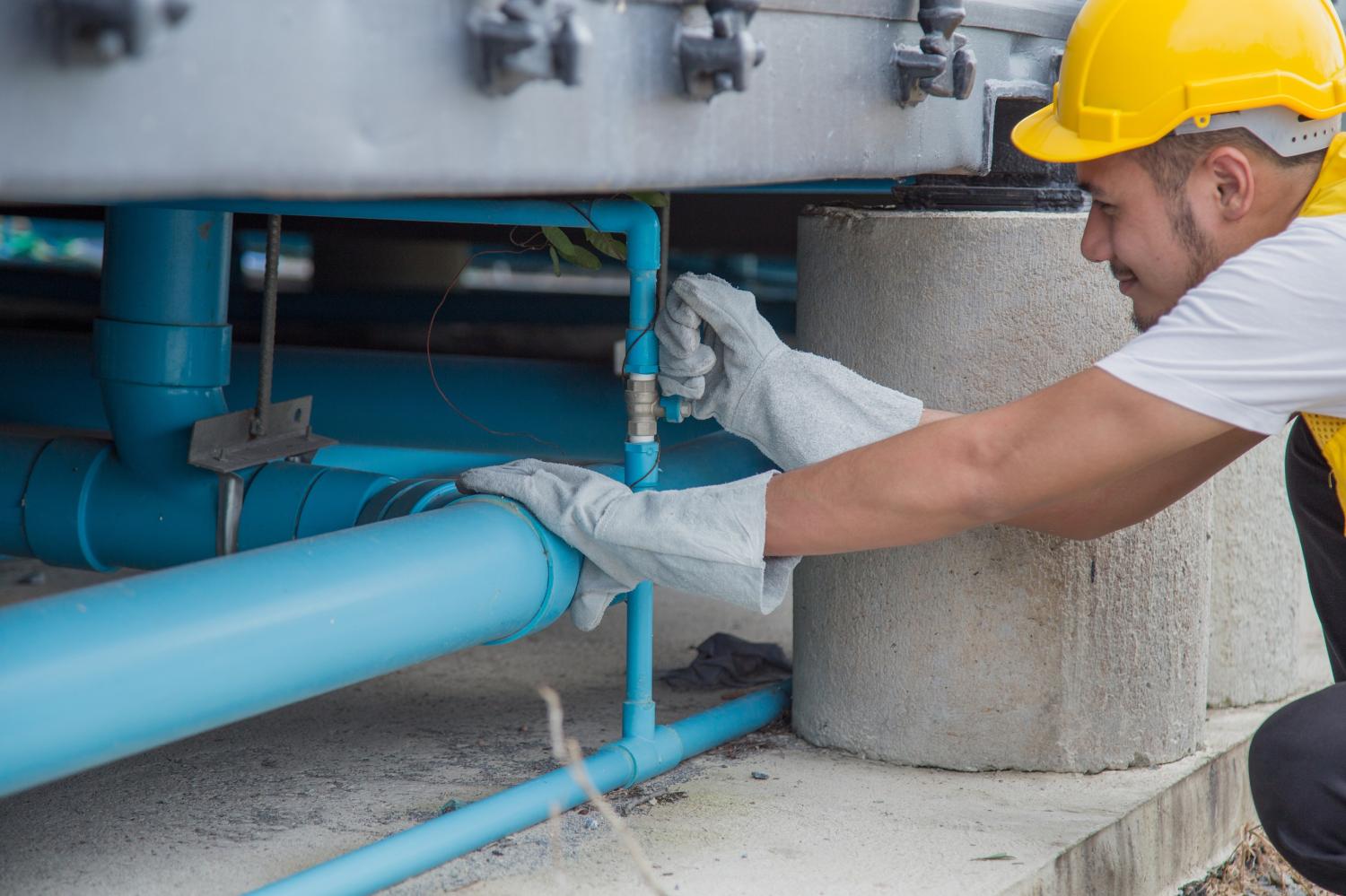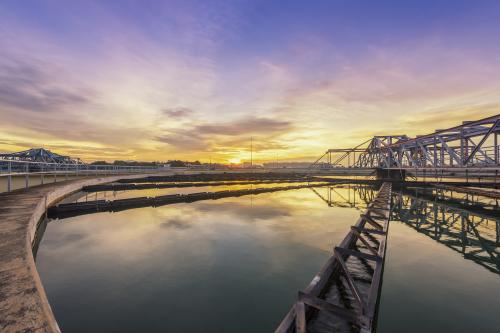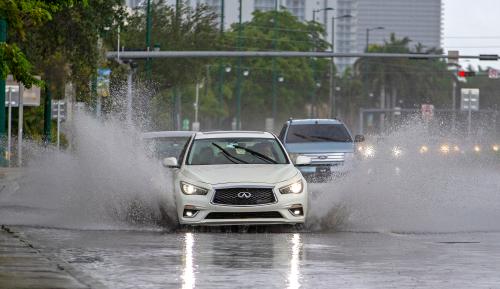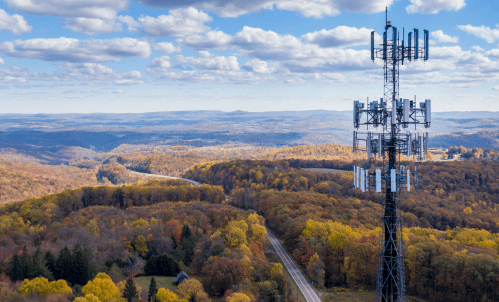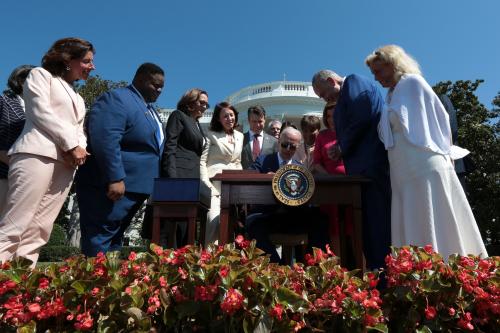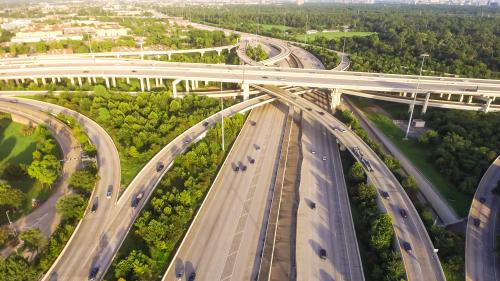This brief is the first of a two-part research series. Click here to read the second research brief.
As the COVID-19 pandemic and recession drag on, millions of households are looking to Washington for answers. State and local leaders have led their own recovery efforts, but there is still desperate need for another federal relief package. But even if another short-term federal relief package materializes, there remains a need for a long-term recovery agenda that can provide greater economic certainty and promote more widespread economic opportunity.
Infrastructure investment offers one way to stimulate the economy that continues to elicit bipartisan support. Upgrading roads, ports, pipes, and other facilities can boost capital spending and create jobs now, plus support long-lasting career pathways and durable economic growth. These improvements also stretch across all types of regions, from urban to suburban to rural communities. The recent election of Joe Biden (aka “Amtrak Joe”) has further raised hopes for action despite a likely divided Congress.
But to truly improve the country’s infrastructure and help the most vulnerable households, federal leaders cannot simply throw more money at shiny new projects. Instead, they must invest with purpose and undo the harms of our legacy infrastructure systems. Too often, households have struggled to afford water and energy bills, to physically reach jobs, or to plug into the internet. This is no accident: Systematic disinvestment, environmental injustices, and racial and economic exclusion have led to infrastructure systems that have posed barriers to opportunity for decades. COVID-19 has only brightened the spotlight on these legacy failures.
Building back better should not only mean building more; sometimes it should also open the door to building less or building differently to better meet the needs of communities. Above all, leaders should prioritize people over projects in our infrastructure plans. In practice, that means defining, measuring, and addressing our infrastructure challenges based on the needs of users of new and existing systems.
This brief explores the country’s legacy infrastructure needs in greater depth by defining the types of inequities that have emerged over time, the escalating costs households face, and considerations for future policy action. A second brief highlights specific federal, state, and local strategies that can mobilize action during the COVID-19 recovery.
Defining legacy infrastructure
Legacy infrastructure systems include roads, pipes, telephone lines, power plants, and transmission lines that were originally designed to provide greater capacity and connectivity, but have also perpetuated inequities in our built environment. In other words, they leave a legacy of harm—threatening health and safety, acting as barriers to economic opportunity, and introducing environmental hazards. These systems include infrastructure that is already in place as well as new infrastructure expansions—bigger highways, for instance—that further cement historic inequities and continue to fail to meet the needs of underserved residents.
Policymakers, planners, developers, and other leaders have frequently overlooked or intentionally disregarded the needs of lower-income households and communities of color when building and maintaining our infrastructure. For example, our transportation and land use policies continue to value highways and low-density, car-centric development, which have long divided and segregated communities based on income and race. Mid-20th-century highways sliced through historic urban cores from Syracuse, N.Y. to San Francisco, and stretched distances for reaching jobs, housing, and other services. Exclusionary zoning of various kinds widened these divides, preserving wealth and opportunity for predominantly white, upper-income neighborhoods while creating additional spatial hurdles for residents who struggled to afford cars and lacked other safe, reliable options to get around.
These inequities continue to pervade many regions. Robert Moses, New York City’s master builder from the 1920s to 1960s, is perhaps the most well-known example of a leader who delivered major projects but prioritized designs that displaced and divided many communities in the process. Since those highways are still in operation and lost family wealth has not been restored, the legacy of Moses’ projects is still with us. While leaders in other states and localities have not followed the exact same path as Moses, they continue to build and maintain infrastructure that leaves many people behind or puts them in harm’s way. North Carolina is still expanding highways through communities and sensitive habitats; Houston is still constructing homes in vulnerable floodplains; and Los Angeles still depends on port traffic that generates enormous air pollution for nearby low-income neighborhoods.
Over time, the result has been a widening infrastructure gap within and across regions, where individuals may experience drastically different realities depending on where they live. Our infrastructure fails to provide reliable and equitable service, especially in localities faced with changing populations, growing climate threats, economic divides, and technological demands. While metro areas such as Seattle, Atlanta, and Boston have many infrastructure challenges, their sustained economic growth and fiscal capacity (pre-COVID-19) have allowed them to invest in more accessible transit options, cleaner water, and digital services. The same cannot be said for slower-growing, fiscally constrained regions.
Flint, Mich. embodies many of these concerns. An older industrial city that has seen its population and economy plummet over the last few decades, Flint depends on aging, inefficient infrastructure that is not only costly to maintain, but jeopardizes the well-being of its lower-income residents. Nearly five years have passed since Flint’s water crisis rippled nationally. Lapses in state oversight and infrastructure maintenance resulted in thousands of lead poisonings, eventually leading Michigan to finalize a $600 million settlement with victims. The significant and lasting health, environmental, and economic impacts to residents and businesses left no real winners.
Our infrastructure systems have failed the residents of Flint and continue to leave a legacy of harm in other communities across the country. And the costs—to our health, environment, and economic livelihood—are only increasing.
Recognizing legacy infrastructure costs
Infrastructure is designed to be long-lived. As a result, both the benefits and harms of major projects are also long-lasting. Since we still typically do not plan or measure our infrastructure needs around broad or rapidly evolving sets of concerns—from transportation access to utility bill affordability to climate resilience—many people are bearing higher health, economic, and environmental costs of legacy infrastructure. The COVID-19 pandemic has simply highlighted the higher dangers and costs some of us face, which have been decades in the making.
Legacy infrastructure’s dangers to our health and safety are widespread, with our transportation systems producing some of the costliest and deadliest outcomes. Inequitable access to transportation—including a lack of transit and walkable options—forces households to buy and maintain cars, which pose a variety of health hazards. Widespread injuries and death are a daily reality in lower-income communities where a mix of elderly and younger residents must navigate streets that are dangerous by design. Black pedestrians often live in neighborhoods without sidewalks, bike lanes, or other street improvements, putting them at heightened risk of death: They account for 18.4% of all pedestrian fatalities, despite making up 12.3% of the U.S. population. Native Americans also face significantly higher pedestrian fatality rates (2.1%) compared to their population share (0.7%).

It is not just an inaccessible and dangerous built environment that perpetuates inequities; the lack of affordability prevents many people from drinking clean water, getting reliable electricity, and depending on other essential services too. Since 2000, water and sewer prices have more than doubled in relative terms, while electricity prices have surged 64%—both surpassing the 48% increase across all items according to the Consumer Price Index. Although harder to measure, the price of wireline and wireless broadband has also been a concern. When combined with increases in housing, gasoline, and other infrastructure-related expenses, households—particularly lower-income households—are struggling to keep up.

Lower-income households and communities of color have also faced disinvestment, displacement, and outright destruction amid the COVID-19 pandemic and a changing climate. Home values in majority-minority neighborhoods have historically lagged behind those in white neighborhoods, perpetuating decades of property devaluation, neglected infrastructure, and environmental injustices. In addition to greater air and water pollution, these neighborhoods also tend to face more intense heat and flooding, while a lack of parks and green space—combined with extensive pavement and impervious surfaces— worsen these dangers. And increasingly, lower-income households of all races and in all places are the most vulnerable to losses in jobs, wages, and properties due to destructive floods and other sudden economic shocks. Even the lack of basic services remains an ongoing challenge; more than 1 million people—including many people of color, lower-income households, and renters—lack secure water access and are in “plumbing poverty,” making it hard to maintain good health and hygiene during the pandemic.

These costs are only a sampling of the wide harms of our legacy infrastructure. For example, lower-income rural localities and tribal nations continue to face the most serious drinking water quality issues due to a lack of funding and attention. Wastewater, stormwater, and flooding challenges hit both lower-income rural and urban areas hard as well. Rising energy costs—including electric bills—remain a burden on lower-income households, which struggle to avoid shutoffs and get assistance. And broadband gaps are not only prevalent in lower-income, difficult-to-reach rural localities and tribal nations that lack available service, but are increasingly seen as a form of digital redlining in urban areas as well.
Laying the groundwork for more equitable infrastructure investment
Now more than ever, we need to address the inequities of our legacy infrastructure systems. This is not to say that we do not need significant new infrastructure investment—we do. But we’ve seen how making opportunistic cost-cutting infrastructure upgrades that rely on the same underlying designs can create further harm, as in the case of Flint.
Any national infrastructure plan during the COVID-19 recovery should not just look to build more of the same or perpetuate existing inequities. Federal leaders need to partner with state and local leaders to better define what systems should stay, what should improve, and what should go altogether. There is no such thing as a “shovel-ready project,” and the temptation to focus on quick wins may compel us to overlook our legacy infrastructure needs—leaving more people and places behind. Addressing our legacy infrastructure will require new ways of talking about local infrastructure needs and ultimately acting on them at both a local and national level.
- A new way of talking about infrastructure needs and investments: Our national infrastructure discussions are largely fragmented by sector and federal budget categories. Taking a place-based and people-first approach will require an overhaul of how we engage communities around local infrastructure needs and priorities. No one needs a highway—they need to get to work or school. Re-centering conversations around needs, outcomes, and services rather than projects or assets—especially in this time of rapidly changing needs—is an essential first step.
Current infrastructure development processes are mostly reactive. Project developers—public and private—take on the risk of doing early design development and feasibility studies, sometimes at great cost, and then present “alternatives” to communities and residents. The result is often a stand-off: Developers are compelled to defend the alternatives offered based on their investment to date, and communities are left with few options but to accept or reject projects wholesale. Breaking this vicious cycle will take new systems for engagement beyond traditional town hall presentations or reactive public comment periods, especially post-COVID-19.
- A new pathway to equitable infrastructure investment and action: In parallel to changing conversations about infrastructure, there are also several opportunities for federal, state, and local leaders to generate more equitable infrastructure outcomes. Recognizing the high and distributed costs of failing to act—especially for and in chronically underserved communities—is an important starting point for reframing how we tackle existing assets and invest in new solutions.
We need to create new incentives—not just new projects—that encourage greater regional experimentation and shared learning. For example, removing outdated highways and enhancing underutilized assets like parks and green space shouldn’t be ad hoc efforts in only a few regions; these efforts should feed into a larger national infrastructure strategy in which state and local leaders have the financial and technical capacity to drive more accessible, resilient designs. Additional federal funding and programmatic guidance around equitable infrastructure upgrades can raise visibility of the issue and, most importantly, prompt action.
The second brief in this series builds off these ideas and lays out four strategies that can help undo the harms of our legacy infrastructure systems. Better defining and measuring our legacy infrastructure needs is a start, but federal, state, and local leaders have a long way to go to address these needs. Even though COVID-19 has exacerbated many of these challenges—limiting our fiscal ability to plan and launch even ordinary infrastructure investments—we have an opportunity to plot out a new recovery agenda. Our current and long-standing infrastructure inequities demand it.


